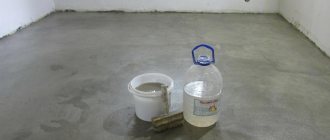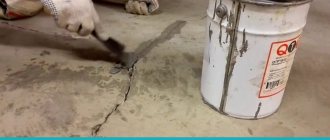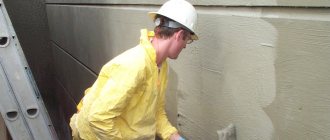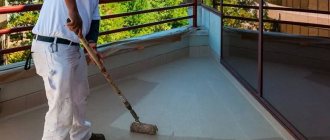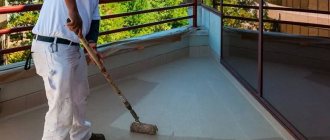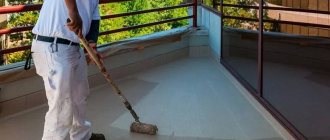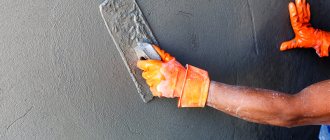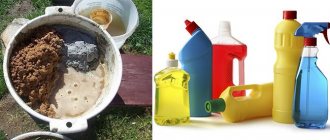The construction industry uses concrete mixtures that, after hardening, have increased strength. To perform special tasks, various additives are added to concrete to change its characteristics. One of the common components is liquid glass for concrete. It reduces the hardening time of the concrete mixture, increases the resistance of the monolith to moisture, acids, and elevated temperatures. It is important to mix concrete and glass correctly to ensure the required material performance is achieved. Let's take a closer look at this additive.
Why add liquid glass to concrete?
Getting to know the material
Many people have heard that the construction industry uses an additive called liquid glass. However, not everyone has an idea of what it is. The ingredient in question is potassium and sodium silicates dissolved in water, derived from silica. Almost everyone has encountered an aqueous solution of silicates when using silicate glue for household purposes. The material is visually perceived as a viscous liquid with a whitish-yellow tint. Let us dwell on the manufacturing technology, according to which the material is classified by type.
Floor screed
Silicates can also be used when pouring floor screeds. It is also recommended to prime the load-bearing surfaces with clean liquid glass. This will make concrete floors water-repellent and protect wood floors from mold and mildew.
A screed is poured over the primed rough surface, into which a silicate solution is added in approximately a proportion of no more than 5% of the total volume of sand concrete.
General classification
Modern technology makes it possible to obtain the additive using various methods. The component can be produced by high-temperature processing of silicon raw materials together with an aqueous solution of sodium hydroxide. The equipment allows you to obtain an ingredient with specified properties by sintering soda with quartz particles. You can also use the method of mixing silicon dioxide with an alkali solution.
Depending on the manufacturing features, two types of ingredients are obtained:
- sodium mixture, characterized by increased adhesion, adhesive properties, resistance to atmospheric factors;
- potassium composition, characterized by accelerated drying, as well as good resistance to elevated temperatures.
The performance characteristics of both types of materials are identical, but the sodium composition has a lower price.
Additive to concrete – sodium liquid glass
Why add liquid glass to concrete?
The use of a silicate solution introduced into the concrete mixture at the preparation stage, as well as external treatment of the concrete surface, changes the properties of concrete.
After liquid glass is introduced, concrete acquires additional characteristics:
- resistance to moisture penetration. Due to its increased water resistance, a monolith modified with a special additive is in demand for foundations and underground structures;
- resistance to elevated temperatures. This allows the use of a modified cement composition for the manufacture of fireplaces and the construction of stoves, the masonry of which is exposed to open fire;
- the ability to harden in a limited time. With an increased concentration of sodium silicate in the working solution, the concrete mixture hardens at an accelerated rate, which is important for sealing various cavities;
- resistance to acids. The introduction of a silicate solution into a concrete composition increases resistance to aggressive environments, which is important for the use of concrete in the chemical industry.
To ensure the required characteristics, when mixing concrete with liquid glass, the proportions must be strictly observed.
Choosing the appropriate proportion
Before starting work, it is very important to calculate the optimal amount of concrete and liquid glass. Here's some data:
- If the amount of glue is 2% of the total mass of the solution, then it will begin to set after 45 minutes, and will gain maximum strength within a day.
- When the amount is increased to 5%, the concrete sets in 30 minutes and hardens in 16 hours.
- At 8%, these figures are reduced to 15 minutes and 8 hours.
- If the liquid glass is 10%, then the time will be 5 minutes and 4 hours, respectively.
Of course, with an increase in the amount of additive, the quality of the finished concrete increases significantly. However, the cost also increases.
Important: If you exceed the permissible dose of the additive, concrete may crumble after just a few days without any load.
Liquid glass in concrete - pros and cons
Just like all building materials, the additive has its advantages and disadvantages.
What does liquid glass give when added to concrete?
Advantages of the additive:
- low price of building materials;
- low additive consumption;
- resistance to atmospheric factors;
- durability of the protective film;
- ease of use when introduced into concrete and surface application;
- good adhesion to mineral bases.
In addition, the silicate component has:
- increased hydrophobizing properties. As a result of creating a waterproof layer, moisture absorption is difficult;
- high antiseptic characteristics. The additive prevents the development of bacteria and impedes the growth of microorganisms;
- antistatic properties. The characteristics of the silicate additive prevent the accumulation of static electricity;
- ability to seal cracks on the surface. This ensures the array is moisture-proof;
- resistance to open fire, acids, and elevated temperatures. The processed material retains its structure and properties.
Along with advantages, there are weaknesses:
- accelerated crystallization of the modified composition when carrying out measures for waterproofing foundations;
- impossibility of use for treating the surfaces of buildings made of brick;
- insufficiently high strength properties of the protective film, which is destroyed under mechanical stress.
Among the insulating materials, liquid glass for concrete stands out
Despite the existing shortcomings, the additive is widely used by professional builders, private developers, and home craftsmen to solve a wide range of problems.
Brand rating
Today, liquid glass is produced by a number of companies. But the leaders whose products are in greatest demand include the following brands:
- Bitumast,
- TEX,
- KonStroy,
- Monomakh,
Some supplements are universal, others have specialization. They also differ in packaging, which allows you to choose the most suitable option.
It is better to purchase products from well-known, well-established manufacturers. After all, having saved several hundred rubles on building materials, you may later encounter serious problems due to their low quality.
Application of liquid glass in concrete - areas of use
Workers in the construction and repair industries actively use silicate solutions based on sodium and potassium. They increase the performance characteristics of the monolith, which allows it to be used for various purposes.
Areas of application of silicate modifier:
- sealing cracks and cavities through which moisture penetrates;
- external finishing of building walls to increase their moisture resistance;
- waterproofing of basement masonry;
- moisture protection of basements, hydraulic facilities;
- preparation of special compositions for priming concrete surfaces;
- construction of foundations for installation of heating equipment;
- production of special types of concrete at industrial enterprises;
- construction of foundations for various objects;
- protection of the walls of residential and utility rooms from the development of mold and fungal colonies;
- processing of joints and internal surfaces of well rings.
Liquid glass is sold in plastic cans
In terms of its characteristics, the component has practically no analogues when performing work related to waterproofing and impregnation. The properties of silicate material make it possible to provide reliable protection of concrete structures from moisture, elevated temperatures, and aggressive environments.
Making a nozzle with your own hands
Before you start using a product made at home with your own hands, you need to go through the following procedures:
- The burner must undergo a quality check at the local Rostechnadzor office in accordance with the regulations established in the Federal Law on the Safety of Buildings and Structures dated December 30, 2009.
- After this check, it is necessary to obtain a certificate from Rostekhnadzor regarding the suitability of the burner for operation.
In order to start making the nozzle, you need the following materials:
- A valve that will serve to regulate the fuel supply of the device. To supply gas to the burner, you must use the valve installed on the gas source.
- Steel pipe. It is desirable that it have a thickness of up to 2 mm and a length of up to 100 mm.
- Steel cap for making a fuel dispenser. You can also use a jet from a blowtorch.
- Steel handle. It can be made from a regular fitting.
- Rubber for handle lining.
- Wire. It will be used for welding.
You will also need the following tools:
- Welding machine.
- Grinder for cutting parts.
For homemade production, an atmospheric nozzle is preferable due to the simplicity of its design. The procedure is as follows:
- First, screw the cap onto the valve. For example, if a standard VK-74 valve is used, then the cap has a conical thread.
- Then, by cutting the existing steel pipe with a grinder to the required size, the nozzle of the future nozzle is made - its basis.
- Next, the nozzle is welded to the cap using wire. In this case, the cap and nozzle should not touch.
- A piezoelectric element is installed, which is needed to activate the device.
After this, the product is ready for installation.
Attention! To install a system for supplying fuel to the stove from a central heating system, you need special equipment and experience working with gas systems
Furnace installation
Furnace installation
When installing a finished unit in a furnace, take into account what materials it is made of:
- If we are talking about a brick stove, then the obvious disadvantage will be the high cost and complexity of such a structure, which can only be assembled by a specialist. In this case, the nozzle is mounted inside the furnace.
- In turn, installing the unit in a metal furnace is much simpler and can be done without the involvement of specialists. In this case, the nozzle is mounted directly into the stove so that the flame enters the boiler in sufficient quantities to form a fuel mixture.
The gas nozzle - the heart of the stove - must be of high quality and correctly installed. If this unit malfunctions, fuel-related problems may occur, which can lead to irreversible consequences.
How much liquid glass to add to concrete - proven recipes
Let's consider how much of the silicate component should be poured into the concrete mixture to perform various tasks.
For the preparation of modified cement mortars and concrete, use the following recommendations:
- The masonry mixture for the construction of fireplaces and stoves is prepared from Portland cement and fine sand, maintaining a ratio of one to three. 18–20% of glass from the total volume of mixed components should be poured into the sand-cement mixture, then add water. All that remains is to mix everything thoroughly until smooth, and the finished solution can be used;
- to prepare a concrete base with moisture-resistant properties, fire-resistant characteristics and intended for domestic use, the concentration of the additive should not exceed one tenth of the total mass. This composition can also be used to waterproof home pools;
- To waterproof the joints of well rings and treat the internal surface, a composition consisting of Portland cement, glass, and sifted sand is prepared. It is very important to maintain proportions by adding ingredients in equal proportions. By gradually adding water, you need to achieve a creamy consistency.
Provided the proportions are observed, the concrete solution acquires the required properties.
Liquid glass as an additive for concrete
Price
Silicate glue is sold in different packaging. Construction stores offer liquid glass both in pure form and a mixture already diluted with water. Mainly the price depends on the manufacturer, container (barrels are always more expensive) and the concentration of the substance.
In small bottles the substance will cost from 15 to 50 rubles per kilogram. For a canister weighing 21.5 kg you will have to pay 700-800 rubles. When purchasing in bulk, manufacturers always sell cheaper. They will ask about 9-10 thousand rubles per ton.
So, soluble glass can significantly improve the properties of concrete structures, which, in turn, will extend their service life. But to get maximum results, you need to adhere to the basic rules. In case of illiterate work, the characteristics of the materials will only worsen.
We pour liquid glass correctly - the additive to concrete does not tolerate mistakes
Situations arise when the introduction of glass does not bring the expected result. This is due to the lack of practical experience and non-compliance with proportions.
It is important to adhere to the following recommendations:
- It is prohibited to introduce a silicate additive into the prepared concrete solution. You must first mix the ingredients, then dilute the glass with water. Then you need to gradually pour in the solution, mixing thoroughly;
- control the percentage of added components, do not exceed the proportions tested in practice. This ensures that the required performance properties of concrete are obtained.
Remember that an increased concentration of silicate filler, as well as a decreased one, negatively affects the properties of concrete.
Popular manufacturers
In construction stores you can most often find the following brands of material:
- "Arbet". Art concrete of high quality at a competitive price, produced in Russia.
- "Dekostroy". The company creates architectural concrete for landscape design.
- San Marco. Materials under the Concret Art brand allow you to create coatings with the effect of aging, cellular concrete and patination.
- "Decorazza." Italian manufacturer of art concrete. Offers material with already added pigments in 15 color variations.
- Introduces “Art Concrete” decorative plaster on the market based on acrylic copolymers and stone chips.
- "Asti." The Russian company produces decorative materials with fine and coarse fillers and with mica additives.
Architectural concrete is an incredibly interesting and multifaceted material that can be used independently in the interior and exterior of a home. It gives you a chance to completely transform your home and area without spending extra money.
Adding liquid glass to concrete - operating rules
To ensure the required effect from using the additive, it is necessary to study the rules for working with silicate additives, as well as prepare the necessary tools.
Waterproofing with liquid glass
For surface treatment of the concrete mass you will need:
- wide roller to speed up the application of the protective composition;
- brush for treating small areas and corner areas with a silicate mixture;
- metal brush for preparing the surface to be treated;
- a spray gun that allows you to apply material when performing work on an industrial scale;
- container for mixing ingredients and preparing special mortars;
- protective gloves that protect the skin from contact with the silicate component.
General operating rules provide:
- Thorough cleaning of the treated surface from contaminants of organic and inorganic origin.
- Sealing deep cracks and leveling the surface using concrete putty.
- Layer-by-layer application of material using a wide roller, brush or industrial spray gun.
When the coating is applied in two layers, it penetrates 1.5–2 mm deep into the array. The modifying composition does not contain harmful components, however, you should wash the skin with water if the silicate solution gets on its surface. After completing the work, it is necessary to inspect and clean the tool from any remaining silicate mixture.
You can introduce the additive into the concrete solution at the preparation stage. To do this, you need to gradually add liquid glass for concrete to the concrete mixer or container. The instructions for use must be followed to ensure the required concrete characteristics.
How to cover a concrete floor with liquid glass
To prepare a modified concrete composition, you will need the following tools :
- a special attachment for the drill that increases the efficiency of mixing the components;
- a container for mixing components using a nozzle or a small-sized concrete mixer;
- Personal protective equipment that protects the skin and mucous membrane from getting the additive.
The algorithm for preparing a modified concrete composition involves the following operations:
- Dosing of ingredients in the required proportions.
- Adding an aqueous solution of a special additive to the concrete mixture.
- Preparation of the concrete mixture according to the recipe.
- Thoroughly mix the components until a homogeneous consistency.
When pouring liquid glass into concrete yourself, the proportions must be strictly observed. Exceeding the amount specified in the recipe will cause accelerated drying of the concrete with the appearance of cracks. Adding a reduced volume of liquid glass to concrete will not provide the required performance characteristics.
Preparing the base and applying impregnation [Recommendations from experts]
The drug is sold in plastic containers with a capacity of 0.8-55.0 liters, or in barrels of 200 liters. The composition itself is ready for use, all that is required is to mix it with a spatula or a construction mixer, and you can get to work.
Apply the drug evenly over the entire surface so as not to miss a single area, but there should be no puddles;
In cold weather, it is also prohibited to treat external walls or floors covered with frost. Treatment is carried out only on a dry and clean surface.
How to properly prepare a concrete base
Whether it is a basement floor or a wall, the surface must be cleaned not only of dirt and dust, but also of traces of paint, layers of iron and other debris.
To do this you will need a handy tool:
- putty knife;
- chisel;
- metal brushes, etc.
For large areas, professional equipment is used.
Treatment of roofs and floors with liquid glass
Apply the adhesive solution after preliminary preparation:
- Be sure to remove old coating, debris, pieces of concrete and other contaminants.
- Then the surface is treated with bitumen, following the technology, with a thickness of 2 mm.
- When the emulsion hardens, liquid glass up to 3 mm thick is poured over it.
- The layer is leveled with a spatula.
- After this, take a short break for up to 3 hours and apply the finishing layer.
Covering plinths and basements
To protect wet rooms and building basements, a mixture consisting of silicate glue, cement and water is used. To prepare the solution, you will need a container with a volume of 10-15 liters: a small construction basin is quite suitable. Cement is poured into it, water is added and glue is added, all this is mixed to the desired consistency.
The surface is treated with a wide brush or paint roller. Considering that the setting time of the composition is limited to 30 minutes, all tools must be prepared in advance. Before applying the solution, the surface is cleaned of dirt, crumbled plaster is removed, and paint is removed.
Wall and ceiling treatment
Impregnation work is carried out in two stages:
- First, apply the first liquid layer of adhesive solution with water. The composition is prepared in a ratio of 4:1.
- It is recommended to go through areas closer to the base 2-3 times. If necessary, you can use a spray gun by connecting it to an industrial vacuum cleaner. In this case, you will have to apply additional security measures. Although the solution does not emit toxic substances, it is advisable to protect your body with overalls.
